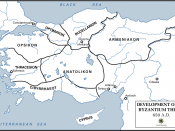The Gypsy peoples originate from Sind region now in Pakistan. Their Rom language is close to the older forms of Indian languages. The three tribes of Rom, Sinti, and Kale probably left India after a succession of campaigns in Sind through the C11, initially spending time in Armenia and Persia, then moving into the Byzantine Empire after the Seljuk Turk attacks on Armenia. Within the Byzantine Empire they dispersed into the Balkans reaching Wallachia (1385) (now Romania) ahead of this area falling to the Ottoman Turks. Other groups also moved through India to Gujarat and south of Delhi. Gypsy populations can still be found along all these migration routes.
When entering west Europe they initially had letters of protection from the King of Hungary. This privileged situation did not last long as amazement at their way of life commonly led to hostilities. The Gypsy way of life still leads to hostilities from the people of their host nations.
Europeans regard "private property" as sacrosanct, whereas gypsies do not have a word for "possess", which gives rise to two incompatible ways of life and a continual problem of gypsies being regarded as "thieves" from the European's view.
In each host nation gypsies appear to take on the religion, names and language of their hosts, but within the Rom they maintain their Rom language, names, music, customs and Indian looks. This tight community has meant that after some six hundred years there is still a large population of gypsies not integrated or assimilated with Romanians.
From the time of their arrival in Romania Gypsies were the slaves of the landowners, only to be emancipated in 1851. While in Romania some of the Gypsies took to speaking a version of Romanian called Bayesh which can be heard in some of the songs of...


